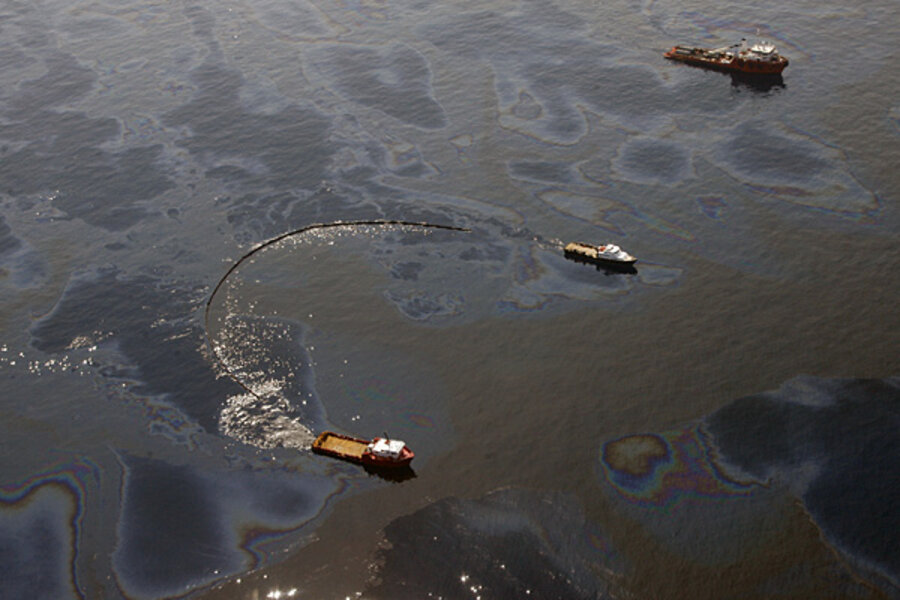BP oil spill: 'top kill' failure means well may gush until August
Loading...
With the failure of the BP “top kill” maneuver, the effort to combat the BP oil spill is increasingly becoming an attempt to manage expectations.
A month ago, when the spill was barely a week old, Interior Secretary Ken Salazar told CNN that the “ultimate relief” – drilling a relief well – was still “90 days out.”
Now, that pronouncement is looking like the most realistic target. BP managing director Bob Dudley said Sunday that the the company's best hope was not in capping the well but in containing and collecting the oil at the source until a relief well is ready in August.
IN PICTURES: Louisiana oil spill
"If we can contain the flow of oil and keep it out of the ocean, that's not a bad outcome," said Mr. Dudley on CNN's "State of the Union," noting that the next maneuver is to fit a new containment valve on the well.
After BP's three unsuccessful attempts to stop or siphon the gushing oil, federal officials also appear to be shifting focus. They are subtly but repeatedly emphasizing that their efforts should be judged by the region’s long-term recovery – not on the immediate issue of whether they can stop the Macondo wellhead from leaking 800,000 gallons of oil a day into the Gulf of Mexico.
Addressing the situation in a statement Saturday, President Obama said: “It is as enraging as it is heartbreaking, and we will not relent until this leak is contained, until the waters and shores are cleaned up, and until the people unjustly victimized by this manmade disaster are made whole.”
As he states, Mr. Obama is not giving up on efforts to contain the leaking oil before the relief well is expected to be ready. The problem is that BP – not the federal government – is best placed and equipped to stop the leak, yet the challenges presented by the Macondo wellhead are so great that BP might be unable to make much headway until August.
Some scientists have noted, without hyperbole, that it would be easier to launch a spacecraft to the moon than shut down the Macondo wellhead, which is 5,000 feet deep. The “top kill” live feed offered a glimpse at this: robot submarines attempting precise maneuvers amid the crushing pressures of pitch-dark waters.
In his Saturday statement, Obama in some ways sounded as though he was in the midst of launching an ad hoc space program to the sea floor. At a time when the nation is wanting him to give the aura of presidential power – that there is no solution beyond the scope of his administration – the statement instead cast him as the reluctant scientist, speaking of probabilities and technical challenges.
With “the surest way to stop the flow of oil – the drilling of relief wells” – needing “several months to complete … engineers and experts have explored a variety of alternatives,” Obama said.
“While we initially received optimistic reports about the [top kill] procedure, it is now clear that it has not worked,” he said, later adding: “While we were hopeful that the ‘top kill’ would succeed, we were also mindful that there was a significant chance it would not.”
So the Coast Guard directed BP to launch a new procedure, he said, “which is not without risk and has never been attempted before at this depth…. It will be difficult and will take several days”
From here on, in fact, any new plans to contain or cap the well will be comparably riskier or less likely to work than “top kill,” which was seen as BP’s best and most reliable option. This is because BP tried the maneuvers it thought most promising first, culminating in the failed “top kill” effort.
The next attempt to stop the leak will involve cutting the riser pipe and fitting a new containment valve, called the lower marine riser package (LMRP), atop it.
If the LMRP works, it could allow BP to collect all the oil leaking from the wellhead. If it fails, it could increase the amount of oil leaking in the Gulf. The riser pipe is kinked like a garden hose, and many scientists believe it is restricting the flow of oil somewhat.
Mr. Dudley countered Sunday that BP estimated that any increase in oil flow would be small.
With the prospect for containing the oil becoming progressively less likely with every mounting failure, Obama and his lieutenants are left to try to prepare Gulf coast residents for the worst without looking as though they have already accepted it.
The long-term federal relief effort, while unsatisfying to Gulf residents watching oil choke their coasts, is at least one area where the government can exercise control.
IN PICTURES: Louisiana oil spill
Related:





